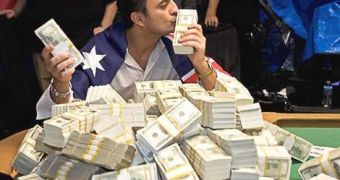If you ask professional poker players, they'll tell you that there's no sure method of winning.
Statistical physicist Clement Sire - and champion bridge player - has created a model of the poker variant Texas hold 'em that enables him to do everything from predicting the length of a tournament to figuring out his ranking and is able to mathematically express many features of the game that experienced players would recognize.
Poker is an especially attractive subject for physicists, because it's one of the few truly isolated systems. Unlike, say, the stock market, which is often governed by factors such as politics, war and weather, poker tournaments are not affected by external phenomena.
Sire's model includes functions that reproduce the most basic tasks a poker player must carry out, such as deciding whether to bet strictly on the strength of his or her hand, but also more complex problems, like the number of chips and the number of players.
One feature of Sire's model came directly from his own experience playing in poker tournaments. "I noticed when playing that when I had twice the number of chips as the average," he says, "I was typically in the 10 best people of a 100-person tournament." The physicist also discovered that the maximum number of chips held by the "chip leader," or the player with the most chips at any given time, as well as the total number of chip leaders, are both a function of the number of players who enter a tournament. (Specifically, they're proportional to the logarithm of the initial number of players.)
He found that his empirical observations were correct and, also, that his model almost perfectly matched the data he had gathered from online poker tournaments.
It turns out that the distribution of the "stack," or fortune, of the chip leaders across tournaments mirrors the pattern found in the distribution of maximum temperatures during every August in history or countless other natural phenomena where physicists have attempted to predict the nature of extreme values.
This pattern, called the Gumbel distribution, means that the frequency with which chip leaders accrue fortunes of any given size is, in a way, a natural phenomenon that arises as much from the characteristics of the game being played as from the dispositions and abilities of those playing it.
Sire's ability to reproduce many of the characteristics of a poker tournament indicates that, when taken as a whole, the features of these tournaments are entirely predictable.
Before anyone attempts to use Sire's model to plot a winning strategy, however, they should take heed of Sire's findings and study them in detail.
Who knows, maybe by combining the statistical results of the study with deep understanding of the game, an experienced player could come up with the "endless winning streak".

 14 DAY TRIAL //
14 DAY TRIAL //